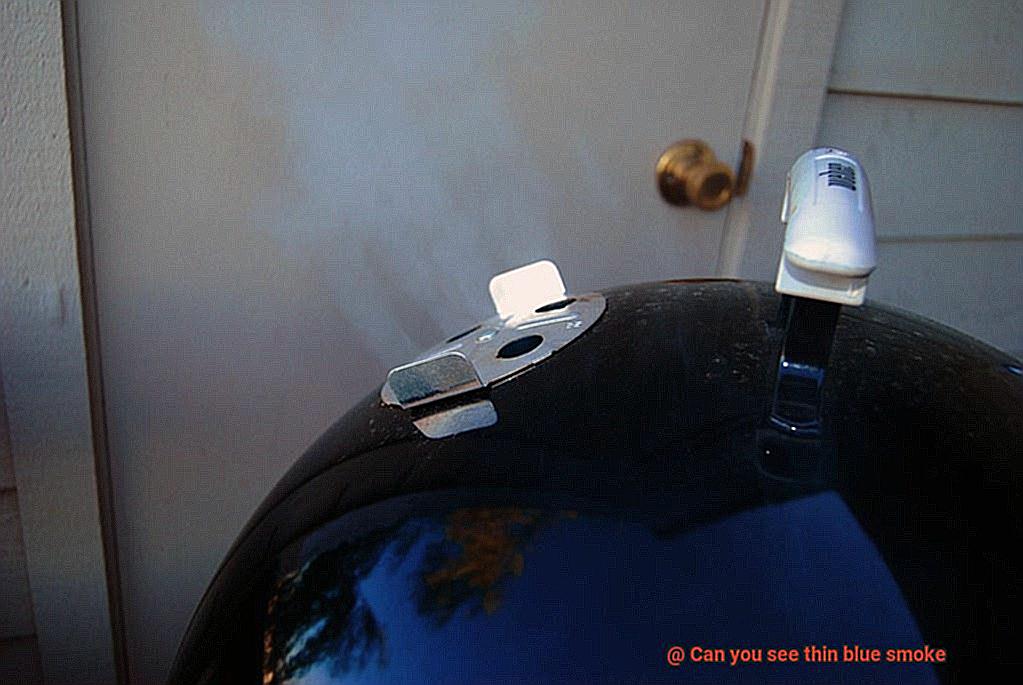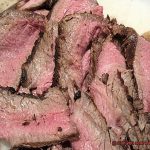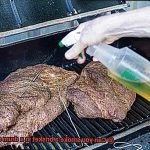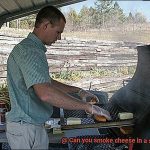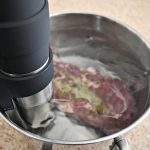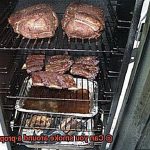Do you love the smell of smoked meat wafting from your grill or smoker? Have you ever noticed the thin blue smoke that seems to dance around your food, adding a mesmerizing touch to the experience? If so, you’re not alone. Many barbecue enthusiasts swear by this type of smoke, claiming it’s the secret ingredient to achieving mouth-watering flavor and tenderness in their meats.
But what exactly is thin blue smoke, and why does it matter? In this blog post, we’ll take a closer look at this phenomenon and explore its significance in grilling and smoking. We’ll start by breaking down what causes thin blue smoke and how it differs from other types of smoke. From there, we’ll dive into the benefits of using this type of smoke for your food’s flavor profile and smokiness level.
But that’s not all – thin blue smoke also plays a crucial role in temperature control during cooking, allowing for more precision and consistency in your results. We’ll share some tips on how to achieve this type of smoke and ensure your meats are cooked to perfection with just the right amount of smoky goodness.
Whether you’re an aspiring grill master or a seasoned pro, understanding the science behind thin blue smoke can take your culinary creations to new heights. So join us on this journey as we unravel the mystery behind one of barbecue’s most beloved elements. Get ready to elevate your grilling game with the power of thin blue smoke.
Contents
What is Thin Blue Smoke?
Thin blue smoke is produced when wood or charcoal burns at a consistent temperature with enough oxygen. This type of smoke is almost invisible and has a blue tint to it. Unlike thick white smoke that can leave a bitter taste on your food and have an unpleasant smell, thin blue smoke imparts a subtle and delicate flavor to whatever you’re cooking.
But how do you achieve this highly sought-after type of smoke? It all comes down to temperature control. To produce thin blue smoke, you need to keep the temperature in your smoker low and steady. This means using a quality smoker with good ventilation and monitoring the temperature closely throughout the smoking process.
Here are some tips for achieving thin blue smoke:
- Start with dry wood or charcoal: Wet wood or charcoal can produce thick, billowing smoke, which can cause your meat to taste bitter.
- Use a smoker with good airflow: A smoker with poor ventilation can cause the wood or charcoal to smolder and produce thick smoke.
- Monitor the temperature: Keep a close eye on the temperature in your smoker and adjust as needed.
- Be patient: Achieving thin blue smoke takes time and patience. Don’t rush the process or try to crank up the heat to speed things up.
When you’re producing thin blue smoke, you’ll notice that the smoke coming out of your grill is almost invisible and has a bluish tint to it. If you’re seeing thick white smoke, it’s an indication that the temperature in your smoker is too low, and you need to adjust it.
What are the Benefits of Using Thin Blue Smoke?
Thin blue smoke is the term used to describe the type of smoke produced by hardwoods like oak, hickory, and mesquite when they burn. When you cook with thin blue smoke, it has many benefits that can enhance the flavor and appearance of your food.
Firstly, using thin blue smoke adds a distinct, smoky flavor to your food that’s different from the charred taste you get from direct heat cooking. It infuses your food with a rich, complex taste that’s difficult to replicate with other cooking methods. It’s like adding a secret ingredient to your recipe that elevates it to a whole new level.
In addition to flavor, thin blue smoke enhances the appearance of your food. The smoke creates a beautiful golden-brown color on your meat or vegetables, making them more appetizing and visually appealing. This color not only looks good but also adds depth and character to your dish.
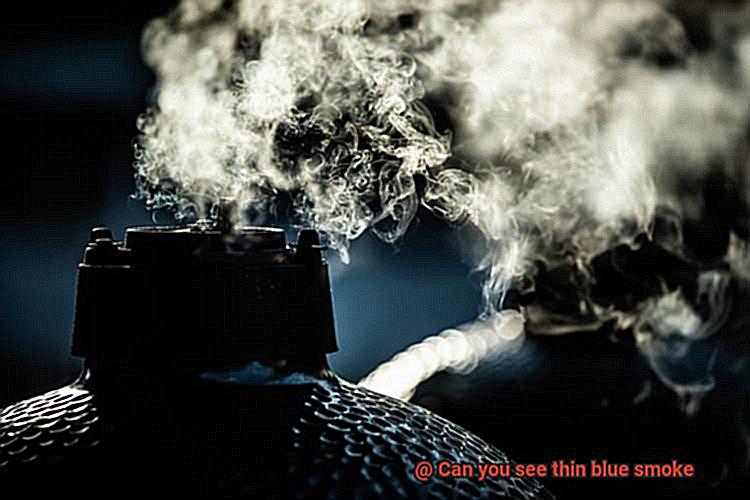
Another benefit of using thin blue smoke is that it regulates the temperature in your grill or smoker, preventing hot spots and ensuring even cooking. With consistent heat throughout the cooking process, you’re guaranteed perfectly cooked meals every time.
Lastly, cooking with thin blue smoke is a healthier option than other cooking methods. Grilling or frying food can produce harmful chemicals like acrylamide and heterocyclic amines (HCAs), linked to cancer and other health problems. Luckily, when you cook with thin blue smoke, you avoid these harmful chemicals and create a healthier meal for yourself and those around you.
How Can You Tell If You’re Producing Thin Blue Smoke?
Then, understanding how to produce thin blue smoke is essential. Thin blue smoke is the holy grail of smoking, and it’s what separates the novice from the expert. As an expert in the field, I’m here to guide you on how to tell if you’re producing thin blue smoke and how to adjust your fire to achieve that perfect flavor for your next BBQ.
Thin blue smoke has a pale blue color and wispy texture. It indicates that your fire is burning clean and efficiently, resulting in optimal flavor and evenly cooked food. But how can you tell if you’re producing this elusive smoke? It’s all about observing the color and texture of the smoke coming from your grill.
If the smoke is thick and black, it means that your fire is not burning cleanly. Thick black smoke can impart a bitter flavor to your food, making it unappetizing. Conversely, if there’s no smoke at all, it means that your fire may not be hot enough, and you may need to add more fuel.
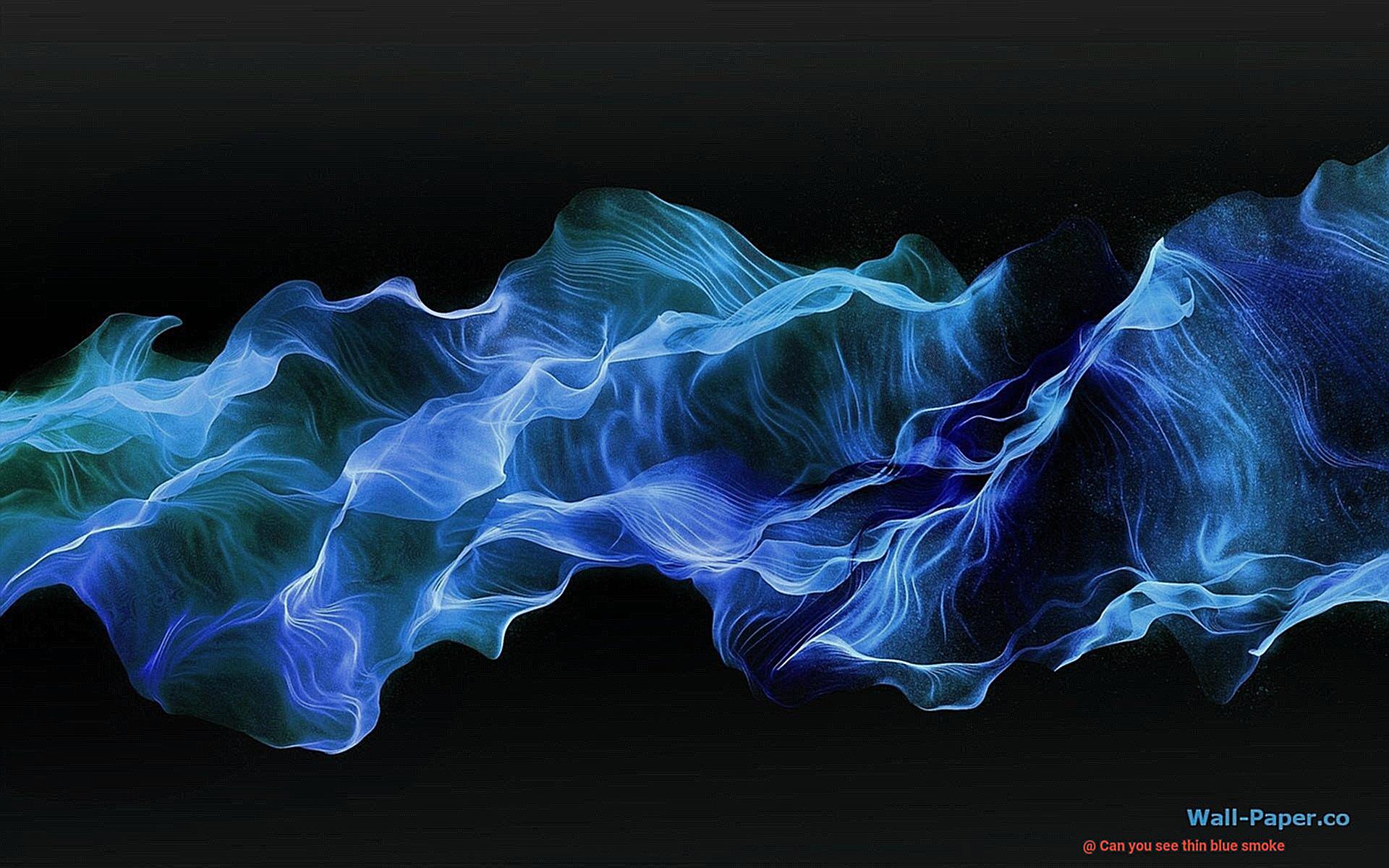
To produce thin blue smoke, start by ensuring your fire is well-established by allowing it to burn for at least 20-30 minutes before adding any food. Once you add food, keep a close eye on the smoke coming from your grill. If you notice that the smoke is becoming thicker or darker, adjust your fire accordingly by opening or closing the vents or adding more or less fuel.
How to Increase Airflow and Temperature for Thin Blue Smoke
You need to focus on increasing airflow and temperature in your smoker. These two factors are crucial for producing a consistent burn and a delicate smoky flavor that will make your food stand out. Here are some tips to help you achieve thin blue smoke:
Adjust Your Dampers
One of the easiest ways to increase airflow in your smoker is by adjusting the dampers. Most smokers have multiple dampers, including one on the top and one on the bottom. By opening them up, you can allow more oxygen into the smoker, which will help fuel the fire and increase smoke production. However, be careful not to open them too much, as this can cause the temperature to rise too quickly and lead to an uncontrolled fire.
Use a Fan or Blower Attachment
If your smoker doesn’t have adjustable dampers, or if you want to increase airflow even more, consider using a fan or blower attachment. These attachments can be added to some smokers or grills to help increase air circulation and maintain a consistent temperature. They can also help distribute smoke evenly throughout the cooking chamber, resulting in a more flavorful end product.

Monitor Your Temperature
Temperature control is just as important as airflow when it comes to achieving thin blue smoke. If your smoker is too hot, it can cause the wood chips or pellets to burn too quickly, creating thick white smoke. If your smoker is too cool, it may not produce enough smoke at all. To maintain an ideal temperature in your smoker, use a thermometer to monitor the temperature and adjust the dampers accordingly.
Experiment with Wood Type
Another way to achieve thin blue smoke is by experimenting with different types of wood. Some woods, such as hickory and mesquite, produce a lot of smoke and can create a thicker smoke than other woods like apple or cherry. By experimenting with different wood types, you can find the perfect balance of smoke production and flavor for your taste preferences.
Clean Your Smoker Regularly
Lastly, make sure to clean your smoker regularly to ensure proper airflow and temperature control. A smoker that is clogged with ash or debris can hinder airflow and prevent the wood chips or pellets from fully igniting. Regular cleaning will help maintain optimal conditions for achieving thin blue smoke.
Tips for Mastering the Art of Producing Thin Blue Smoke
This type of smoke is the gold standard in grilling and smoking, indicating that you have achieved the perfect balance of heat and smoke. But how do you produce this elusive smoke? Let’s explore some tips together.
Tip #1: Start with Quality Wood
The type of wood you use can greatly affect the quality of smoke produced. To produce thin blue smoke, look for high-quality smoking wood such as hickory, oak, or applewood that is free from chemicals or additives. These woods burn slowly and consistently, making them perfect for achieving that thin blue smoke.
Tip #2: Allow the Wood to Smolder
To produce thin blue smoke, you want the wood to smolder slowly rather than burn quickly. This can be achieved by soaking your wood chips or chunks in water before adding them to your smoker or grill. Soaking the wood will slow down the burning process and produce a clean-burning smoke.
Tip #3: Control the Temperature
Temperature control is crucial when it comes to producing thin blue smoke. You want to maintain a steady temperature of around 225-250°F throughout the cooking process. This will allow your wood to smolder slowly and produce clean-burning smoke.
Tip #4: Use a Smoker Box
If you’re using a gas grill, consider using a smoker box to hold your wood chips and produce smoke without directly exposing them to the flames. This will help prevent the wood from burning too quickly and producing thick white smoke.
Tip #5: Monitor the Smoke
Keep an eye on the color and volume of the smoke being produced. Thin blue smoke should be barely visible and have a sweet aroma. If your smoke is thick and white, this indicates that the wood is burning too quickly and needs to be adjusted. Adjust the temperature or add more wood as needed to achieve that perfect thin blue smoke.
Different Types of Wood and Charcoal Used to Produce Thin Blue Smoke
Grilling is a time-honored tradition that has been around for centuries. From family gatherings to summer barbecues, grilling is a fun and delicious way to cook food. However, if you want to produce thin blue smoke, it’s important to choose the right wood and charcoal for your grilling needs. Here are five different types of wood and charcoal used to produce thin blue smoke.
Hardwood
Hardwood such as oak, hickory, and mesquite are popular choices among smokers. These woods burn at high temperatures, producing a clean and consistent smoke. They also add a unique flavor to the meat being smoked. Hickory is an excellent choice if you’re looking for a strong, smoky flavor that pairs well with beef or pork. On the other hand, mesquite is known for its bold and intense flavor that works well with red meats.
Fruitwood
Fruitwood such as apple, cherry, and peach are milder than hardwood but still produce a flavorful smoke. They burn at lower temperatures and work well for smoking poultry and fish. Cherry wood is an excellent option if you want a sweet and fruity flavor that complements poultry or fish.
Charcoal
Charcoal is made from hardwood that has been heated in the absence of oxygen, creating a fuel source that burns hotter and longer than wood. It produces less smoke than wood but still gives a nice smoky flavor to the meat being smoked.
Lump Charcoal
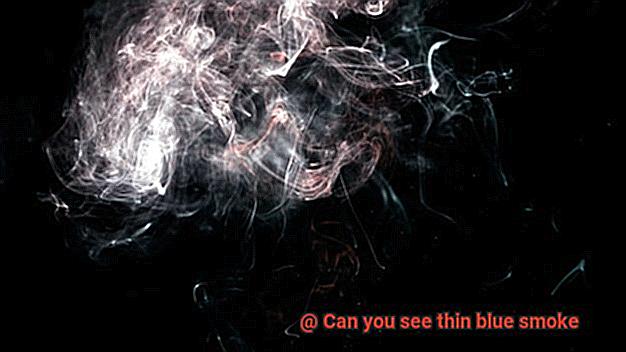
Lump charcoal is made from natural hardwood, and it burns hotter and cleaner than regular charcoal. It produces less ash and imparts a milder smoky flavor to the meat.
Briquettes
Briquettes are compressed charcoal dust mixed with fillers such as sawdust or paper pulp. They burn longer than lump charcoal but produce more ash and less heat.
When selecting the type of wood or charcoal to use for smoking, consider the type of meat you will be cooking and the flavor profile you want to achieve. It’s always best to experiment with different woods and charcoals until you find your preferred combination.
It’s important to note that no matter what type of wood or charcoal you choose, it’s essential to ensure that it’s properly seasoned and dry before use. Wet or green wood can produce thick white smoke that can overpower the food with a bitter taste. Properly seasoned wood and charcoal will produce thin blue smoke that imparts a delicious smoky flavor without overpowering the meat being smoked.
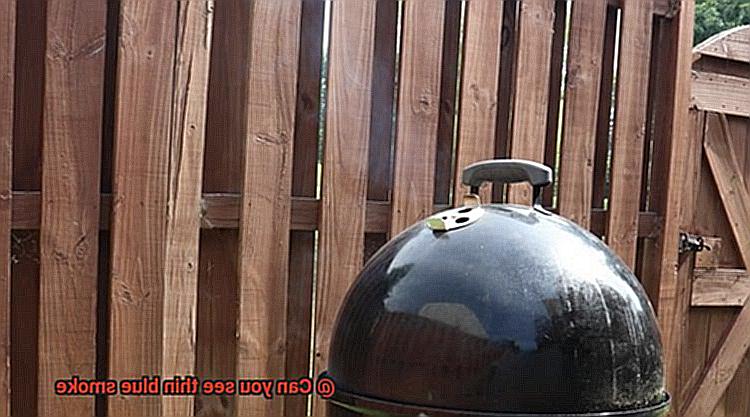
The Best Grilling Techniques for Producing Thin Blue Smoke
As any grill master knows, achieving the perfect smoke is key in creating succulent and flavorful meats. And when it comes to smoke, nothing beats the thin blue variety. In this article, we’ll dive into the best grilling techniques for producing that elusive and delicious thin blue smoke.
First things first, let’s talk about fuel sources. Choosing quality hardwood or lump charcoal is crucial in producing thin blue smoke. These types of fuel produce less ash than briquettes and maintain a consistent temperature, which is essential for achieving that perfect smoke. Remember, adding too much fuel can cause temperatures to spike and produce thick white smoke, so it’s important to keep a steady temperature by adjusting your air vents and avoiding lid openings.
Next up is wood selection. Using wood chips or chunks can help achieve thin blue smoke, but it’s important to choose the right type of wood for your meat. Hardwoods like oak and mesquite work well for beef or pork, while fruitwoods like cherry add sweetness to poultry or fish.
Soaking the wood in water for at least 30 minutes before adding it to the fire can also help prevent it from burning too quickly and producing thick white smoke.
Now let’s talk about controlling the burn rate of your wood chips or chunks. Utilizing a smoker box or foil packet can help with this, resulting in a cleaner smoke. Simply place your wood in the box or packet and poke holes in it to allow the smoke to escape. Placing your meat on a lower rack or using indirect heat can also help prevent flare-ups and ensure an even cook.
Common Mistakes When Trying to Produce Thin Blue Smoke
Producing thin blue smoke is an art that requires a combination of skill and knowledge. In this post, we’ll discuss the common mistakes people make when trying to produce thin blue smoke so that you can avoid them and take your grilling game to the next level.
First and foremost, the most common mistake people make is using too much wood or charcoal. Though it’s tempting to add more fuel to the fire, this results in thick white smoke which ruins the taste of your food. Remember, less is more when it comes to producing thin blue smoke.
The second mistake is not letting the coals or wood burn down enough before adding your food. This is crucial because if you add your food too early, you’ll get thick white smoke which will make your food taste bitter and acrid. Wait until the flames have died down and the coals are glowing red before you start cooking.
The third mistake is not controlling the airflow properly. Proper ventilation is essential for producing thin blue smoke. Ensure that your grill or smoker has proper ventilation and use a damper to control the airflow. This will ensure that your fire burns efficiently and produces a steady stream of thin blue smoke.
Lastly, not properly seasoning or marinating your meat can also result in thick white smoke. Excess moisture from seasoning or marinating can create more smoke than necessary, ruining the taste of your food. Ensure that you pat dry your meat before adding it to the grill or smoker to avoid this mistake.
wf4HT8l36kg” >
Conclusion
In conclusion, the art of producing thin blue smoke is a skill that requires knowledge and practice. Achieving this delicate type of smoke is critical to ensuring optimal flavor and evenly cooked food. Thin blue smoke has a pale blue color and wispy texture, indicating that your fire is burning clean and efficiently. The key to producing it lies in temperature control – keeping the temperature low and steady throughout the smoking process.
Using thin blue smoke adds a distinct smoky flavor to your food that’s different from the charred taste you get from direct heat cooking. It also enhances the appearance of your food by creating a beautiful golden-brown color on your meat or vegetables, making them more visually appealing and appetizing. Moreover, it regulates the temperature in your grill or smoker, preventing hot spots and ensuring even cooking.
However, achieving thin blue smoke can be challenging as common mistakes can ruin the taste of your food. These include using too much wood or charcoal, not letting the coals or wood burn down enough before adding your food, not controlling airflow properly, and not properly seasoning or marinating your meat.
To produce thin blue smoke successfully, you need to use dry wood or charcoal with good airflow in your smoker while monitoring the temperature closely throughout the smoking process. Patience is also essential as rushing can lead to over-smoking or undercooking.
In summary, mastering how to produce thin blue smoke takes time but can elevate your culinary creations to new heights.

